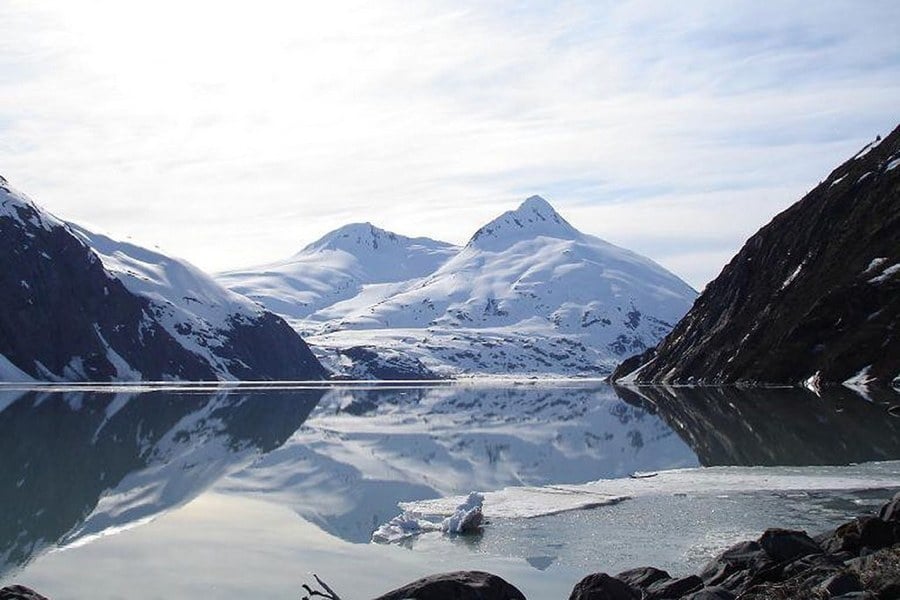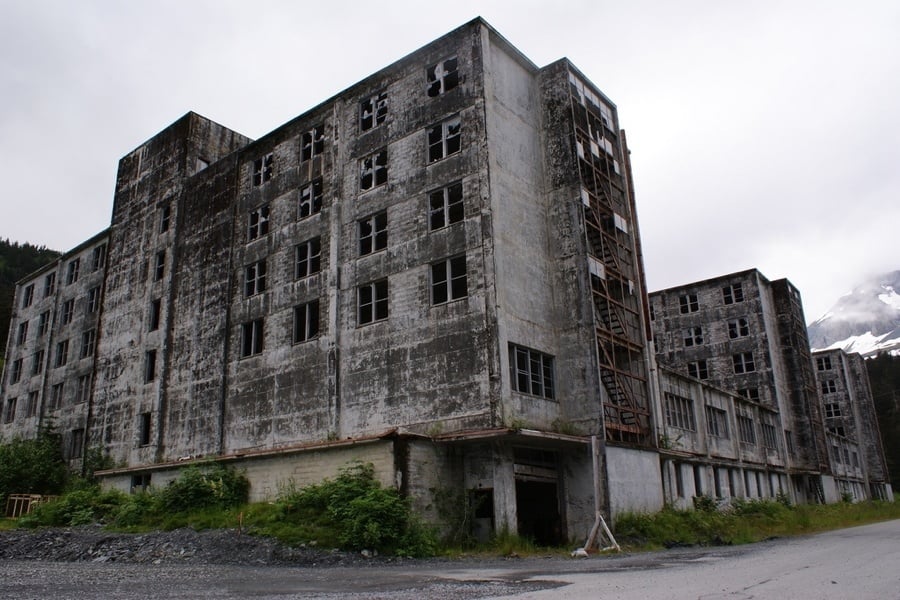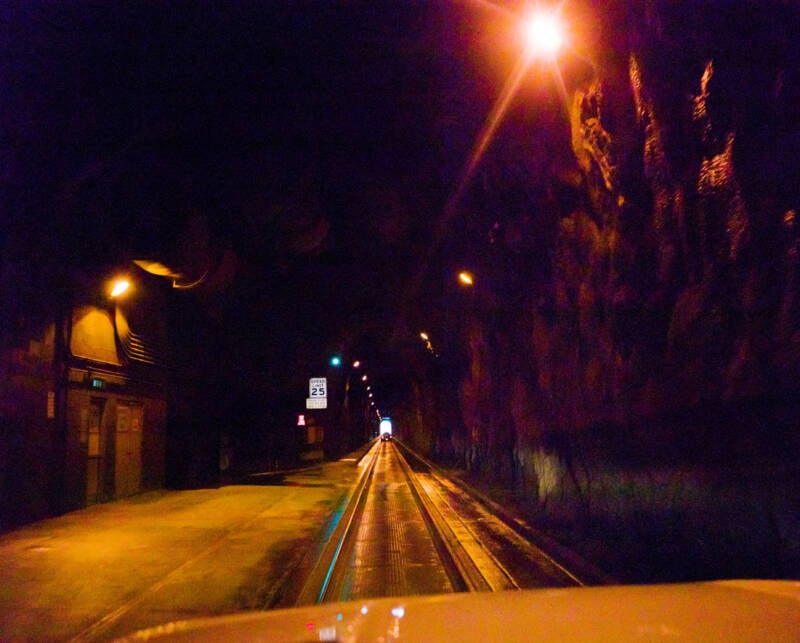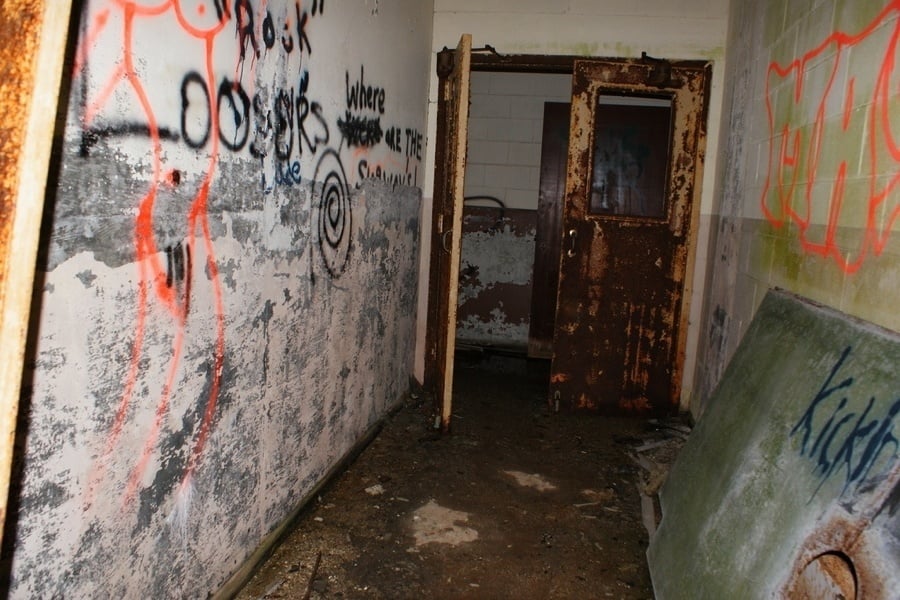About 60 miles away from Anchorage, at the head of the Passage Canal, lies Whittier, a town where nearly the entire population lives in a single building called Begich Towers.

Wikimedia CommonsWhittier, Alaska is home to approximately 272 people, most of whom live in Begich Towers (right).
If you have to go to the grocery store, the post office, the laundromat, or even the doctor’s office or the police station, chances are that any one of those trips will involve a car, train, bus, or bike ride — or at least a long walk.
But if you happen to be a resident of Whittier, Alaska, all of these trips can be done in a very short walk that doesn’t even take you outdoors.
That’s because this peculiar town mostly exists under one roof. Whittier is so often battered by inclement weather that nearly all of the residences, businesses, and public services are housed in a single building.
The Stunning Natural Beauty Surrounding The “Town Under One Roof”

NOAA/FlickrAlaska’s Passage Canal is often described as a “gateway” to the Prince William Sound.
Though it sits only about 60 miles away from Anchorage, Whittier is a remote outpost enveloped by mountains on one side and water on the other.
Situated at the head of the Passage Canal, Whittier boasts unique access to the Prince William Sound, a beautiful yet somewhat off-the-beaten-path body of water. Unfortunately, some outsiders know the Prince William Sound best for being the site of the calamitous Exxon Valdez oil spill in 1989.
But despite that environmental disaster and the increasing effects of climate change in recent years, Prince William Sound is still home to an array of stunning wildlife, including bald eagles, porpoises, orca whales, sea otters, and various seabirds. Whittier is also located near the Chugach National Forest, which features remarkable views of glaciers, fjords, and local wildlife.
The natural beauty of the region is largely thanks to the subarctic climate and the heavy precipitation. But even though the greenery surrounding the town is lush, the climate is more hospitable for wildlife than people.
In fact, the amount of wildlife undoubtedly dwarfs the human population in the region, especially in Whittier, which is home to only about 272 people. And what’s even more remarkable than the town’s tiny size is the fact that nearly all of its residents live inside just one 14-story building, Begich Towers.
Whittier, The Storied “One-House Town”

sf-dvs/Flickr/Wikimedia CommonsBegich Towers, the high-rise building that houses most of the population in Whittier, Alaska.
Perhaps unsurprisingly, Whittier, Alaska has a military past. First established by the U.S. Army during World War II to help with the war effort and to serve as a supply route for the Alaska Railroad, Whittier had to be built to handle the region’s weather — and the possibility of an attack from an enemy.
By the time of the Cold War, the military had constructed a robust, high-rise building so that soldiers and their families could use them as barracks. That structure eventually became known as Begich Towers. Standing 14 stories tall, Begich Towers was built to withstand bombings and inclement weather, and to be mostly self-sufficient for the people who were housed there.
The military remained active in the area until 1960, when Whittier had a population of 1,200 people. Incredibly, some people chose to stay in the area even after the soldiers left. And some new residents moved in.

YouTube/Peter SantenelloAn apartment unit in Whittier, Alaska.
Though the total population quickly and dramatically decreased after Whittier was no longer controlled by the military, about 272 people are still living there today, and most of them reside in Begich Towers.
Due to the unforgiving climate — especially during the winter — many residents of Begich Towers take advantage of the fact that the building essentially is the town, including a health clinic, police station, post office, church, playground, grocery store, and much more all under one roof. The building also boasts a tunnel that children can use to get to school.
Because of the heavy snow, tundra winds, and pouring rain pummeling the area each year, it’s only fitting that the town would essentially bunker into this one, massive, fortified building for warmth and safety.
The Harsh Conditions Of Whittier, Alaska

jeff.emt/TikTokThe Kozy Korner convenience store in Begich Towers. The stock largely depends on what the store’s owners and operators pick up during their regular trips out to Anchorage.
While Whittier’s harsh climate keeps its residents indoors most of the time, the weather conditions aren’t exactly as you might guess. Whittier isn’t simply snowed under and blasted with freezing temperatures all year long.
During half of the year, the town is pummeled with snow, but then, the other half of the year sees it impacted by heavy rain as temperatures rise.
That said, the snowy season in Whittier can be especially perilous due to the powerful winds, with gusts reaching up to 80 miles per hour.
Given conditions like that, it’s hardly surprising that almost everyone in town confines themselves to Begich Towers for much of the year. But that begs the question: Why would someone choose to live here in the first place?

Ainsley-Sorsby/RedditChildren enjoying a playground in Whittier, Alaska.
According to one resident, Erika Thompson, the answer to that question depends on the individual. “Some people love it because it can be really social,” she said. “And some people love it because it can be reclusive.”
Thompson added, “For me it’s just home. For the most part, you know everybody. It’s a community under one roof. We have everything we need.”
While the convenience, peacefulness, and relative remoteness of the town might appeal to some people, others are simply in awe of the region’s natural beauty, which they can admire from their shared home.
Most of the town’s visitors are likewise there to see Begich Towers and the surrounding wilderness. Some guests might be curious about the other buildings in town, most of which are cafes, gift shops, and more residences. But some adventurous outsiders come to see an abandoned building.
The Illicit Exploration Of Whittier’s Infamous Buckner Building

lawrence’s lenses/FlickrThe Buckner Building, an abandoned structure in Whittier, Alaska.
The Buckner Building, once similar to Begich Towers, was constructed as a multi-purpose U.S. Army facility, a second “town under one roof,” so to speak. But the Buckner Building was not repurposed like Begich Towers.
Instead, the Buckner Building was abandoned after the U.S. Army left the town in 1960. This caused the structure to fall into disrepair and become laden with asbestos. Left to rot are the building’s hospital, theater, bowling alley, rifle range, church, bakery, library, and much more.
With such a wealth of abandoned real estate, it almost seemed inevitable that Buckner Building would draw in amateur explorers from out of town. At one point, two daredevils attracted attention online after posting a video of themselves skiing though the building’s stairways and halls.
Thanks to stunts like these, local authorities have kept a closer eye on Buckner in recent years. Potential trespassers have been warned of the dangers of falling debris and the lingering asbestos in Buckner — and threatened with citation arrests and possible fines if they choose to explore the structure anyway. Officials hope that this will discourage people from making the dangerous journey through the crumbling building.
Of course, even getting to Whittier is a journey all its own.
Accessing Whittier Via An Engineering Marvel

H. Mark Weidman Photography/Alamy Stock PhotoThe Anton Anderson Memorial Tunnel is the only way to arrive in Whittier, Alaska by land.
For anyone looking to visit Whittier, Alaska, there is just one way to get there by land: the Anton Anderson Memorial Tunnel. A one-lane tunnel that serves as a route for both cars and trains, Anton Anderson Memorial Tunnel stretches 2.5 miles long and was once part of a World War II railway.
Vehicle traffic in the tunnel — located in a 4,000-foot-tall mountain — changes direction every half hour, but it stops completely whenever a train needs to pass through. During the summer, the tunnel is open from 5:30 a.m. to 11:15 p.m., and during the winter, it’s open from 7 a.m. to 10:45 p.m.
There are no exceptions to this, so residents and visitors need to be either in or out of the town before the tunnel closes for the night.

Wikimedia CommonsAn aerial view of Whittier, Alaska.
Of course, the Anton Anderson Memorial Tunnel isn’t the only tunnel in town. Whittier’s rough climate means that other underground tunnels are needed to connect the area’s few buildings, including the school.
Between Begich Towers’ everything-under-one-roof approach and the underground tunnels, Whittier residents can avoid setting foot outdoors for very long periods of time — sometimes even years if they so choose.
Nevertheless, many of Whittier’s 272 residents — some of whom are transplants from much warmer places like California, Hawaii, American Samoa, and Guam — love their remote, snow-battered home.
One resident named Brenda Tolman, originally from California, called Whittier “God’s little acre” for its beauty and safety, saying there’s nowhere else she’d rather live. However, she also understands this place is not for everyone.
“You gotta be good with being by yourself,” she said. “Or it can get lonely.”
Next, venture beyond Whittier and check out some of the most remote places in all of human civilization. Then, venture to a place much colder than Whittier with these unbelievable Antarctica facts and pictures.






